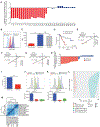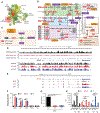Targeting the MTF2-MDM2 Axis Sensitizes Refractory Acute Myeloid Leukemia to Chemotherapy
- PMID: 30115703
- PMCID: PMC7200079
- DOI: 10.1158/2159-8290.CD-17-0841
Targeting the MTF2-MDM2 Axis Sensitizes Refractory Acute Myeloid Leukemia to Chemotherapy
Abstract
Deep sequencing has revealed that epigenetic modifiers are the most mutated genes in acute myeloid leukemia (AML). Thus, elucidating epigenetic dysregulation in AML is crucial to understand disease mechanisms. Here, we demonstrate that metal response element binding transcription factor 2/polycomblike 2 (MTF2/PCL2) plays a fundamental role in the polycomb repressive complex 2 (PRC2) and that its loss elicits an altered epigenetic state underlying refractory AML. Unbiased systems analyses identified the loss of MTF2-PRC2 repression of MDM2 as central to, and therefore a biomarker for, refractory AML. Thus, immature MTF2-deficient CD34+CD38- cells overexpress MDM2, thereby inhibiting p53 that leads to chemoresistance due to defects in cell-cycle regulation and apoptosis. Targeting this dysregulated signaling pathway by MTF2 overexpression or MDM2 inhibitors sensitized refractory patient leukemic cells to induction chemotherapeutics and prevented relapse in AML patient-derived xenograft mice. Therefore, we have uncovered a direct epigenetic mechanism by which MTF2 functions as a tumor suppressor required for AML chemotherapeutic sensitivity and identified a potential therapeutic strategy to treat refractory AML.Significance: MTF2 deficiency predicts refractory AML at diagnosis. MTF2 represses MDM2 in hematopoietic cells and its loss in AML results in chemoresistance. Inhibiting p53 degradation by overexpressing MTF2 in vitro or by using MDM2 inhibitors in vivo sensitizes MTF2-deficient refractory AML cells to a standard induction-chemotherapy regimen. Cancer Discov; 8(11); 1376-89. ©2018 AACR. See related commentary by Duy and Melnick, p. 1348 This article is highlighted in the In This Issue feature, p. 1333.
©2018 American Association for Cancer Research.
Conflict of interest statement
Disclosure of Potential Conflicts of Interest
A.J. Ruthenburg has ownership interest (including stock, patents, etc.) in Epicypher Inc. and is a consultant/advisory board member for the same. No potential conflicts of interest were disclosed by the other authors.
Figures




Comment in
-
Untangling the Role of Polycomb Complexes in Chemotherapy Resistance.Cancer Discov. 2018 Nov;8(11):1348-1351. doi: 10.1158/2159-8290.CD-18-1080. Cancer Discov. 2018. PMID: 30385522 Free PMC article.
References
-
- Thol F, Schlenk RF, Heuser M, Ganser A. How I treat refractory and early relapsed acute myeloid leukemia. Blood 2015; 126:319–27. - PubMed
Publication types
MeSH terms
Substances
Grants and funding
LinkOut - more resources
Full Text Sources
Other Literature Sources
Medical
Molecular Biology Databases
Research Materials
Miscellaneous

